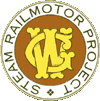


Some Pre-War Reminiscences
by
William F. BOLTON, A.I.R.T.E.
My primary experience of railcars took place at a Great Western running shed not far from London. Among the fairly wide range of machines upon which I lavished my affections and abilities were a number of the self-contained steam railcars then operated by the Company over certain branch lines in the area. They were excellent little jobs and no doubt many readers will recall them to mind. The engine-unit consisted of two cylinders placed outside the frame of one bogie and the pistons were actuated by the means of “D” type slide valves situated over the cylinders themselves.
The drive was, as in usual locomotive practice, fully exposed and the feature that intrigued me was the Walschaerts type valve-gear applied externally. These little machines were the only Walschaerts outside valve-geared engines ever built and operated by the Great Western Railway (the De Glehn compounds were constructed in France). Two of these steam-cars were our particular responsibilities and they worked (at that time) upon such services as the Southall-Brentford double-tracked branch and the Denham-Uxbridge (High Street) route. We frequently rode on one of them each week over the latter line whilst proceeding to attend to the pumping station located at a point where this branch line joined the main London-Birmingham tracks operated by our Company in conjunction with the L.N.E.R. (Great Central Section). This auto-pumping station supplied water for the gravity-tank feeding the Ruislip-Ickenham troughs some distance up the main line; the little railcar invariably wheezed to a standstill on one leg of the “wye” within whose confines the pump-house was located, to allow us to alight onto the permanent-way – much to the consternation of fellow passengers.
These steam-cars as I recall them, had many unusual features. The vertical boiler was situated in the centre of the engineman’s compartment and the chimney led straight through the roof as also did the safety valves and whistle. Inside, one could walk around the boiler and by means of a sliding door behind it, gain access to a fair sized luggage compartment, which isolated the passenger saloons from the boiler room.
Double doors were fitted in each side of the luggage compartment and the passenger saloons – two in number – being separated by a double-doored guard’s vestibule. The smaller of the passenger saloons was used as a smoking compartment and a miniature vestibule located at the far end of the car and equipped with duplicate controls was for use by the driver when running his charge “stern-first”. One advantage of the steam-car over the “auto-train” composed of a pannier tank wedged between two or more trailer-cars, was that there was no need for the whistle signal from the driver riding in the vestibule, when he wished his fireman to link-up the reversing gear after his train had gathered speed.
To return to the boiler-compartment; the coal bunker was placed immediately below the three windows in the bow-ends of the body, and stretched from side to side of the engine-room. The fire-door being located directly opposite the bunker centre it was easy firing for the stoker concerned. No less than eleven windows ensured good-lighting in the enginemen’s compartment, and six of these could be lowered during hot weather, whilst the two doors could be slid aside when necessary.
These steam-cars had a veritable “snort” of an exhaust note, extremely impressive for their size and likely to create consternation in the minds of the uninitiated! To hear one of these cars swinging along the line out of sight sounded for all the world as if some express were cutting the breeze at a steady seventy, and yet, when the car hove into view one would be amazed at such a sound issuing from a train travelling at less than 30 miles per hour! All over the world I have only encountered one other type of machine which could create such an illusion – the Shay-geared locomotive extensively used by timber companies in the New World.
Extracted from an article originally printed in 'Railway Pictorial' - Winter 1946/47.